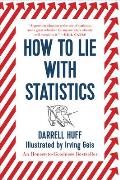 Book Spotlight
Book Spotlight
We teach you two ways to lie
 Our Spotlight this month falls on two books that came to us through our Facebook page. We posted these pictures of the Red/Blue split in US politics to show how the presentation of data can influence (or distort) our understanding of it. James H. of the Goodall Institute pointed out that this is a longstanding technique in many areas, and suggested two classic books that give you all you need to know about how people lie without explicitly (or maybe even intentionally) lying at all. Hopefully, these will be less useful as a way to lie yourself than to not be conned by other people, but hey… the information is yours; do with it as you will. Thanks James!
Our Spotlight this month falls on two books that came to us through our Facebook page. We posted these pictures of the Red/Blue split in US politics to show how the presentation of data can influence (or distort) our understanding of it. James H. of the Goodall Institute pointed out that this is a longstanding technique in many areas, and suggested two classic books that give you all you need to know about how people lie without explicitly (or maybe even intentionally) lying at all. Hopefully, these will be less useful as a way to lie yourself than to not be conned by other people, but hey… the information is yours; do with it as you will. Thanks James!
 “How To Lie With Maps”
“How To Lie With Maps”
by Mark Monmonier
From the Publisher– An instant classic when first published in 1991, How to Lie with Maps revealed how the choices mapmakers make–consciously or unconsciously–mean every map inevitably presents only one of many possible stories about the places it depicts. The principles Mark Monmonier outlined back then remain true today, despite significant technological changes in the making and use of maps. The introduction and spread of digital maps and mapping software, however, have added new wrinkles to the ever-evolving landscape of modern mapmaking.
?Fully updated for the digital age, this new edition of How to Lie with Maps examines the myriad ways that technology offers new opportunities for cartographic mischief, deception, and propaganda. While retaining the same brevity, range, and humor as its predecessors, this third edition includes significant updates throughout as well as new chapters on image maps, prohibitive cartography, and fast maps online. It also includes an expanded section of color images and an updated list of sources for further reading..
 “How To Lie With Statistics”
“How To Lie With Statistics”
by Darrell Huff
From the Publisher– A world-class mathematician and regular contributor to the New York Times hosts a delightful tour of the greatest ideas of math, revealing how it connects to literature, philosophy, law, medicine, art, business, even pop culture in ways we never imagined
Did O.J. do it? How should you flip your mattress to get the maximum wear out of it? How does Google search the Internet? How many people should you date before settling down? Believe it or not, math plays a crucial role in answering all of these questions and more.
Math underpins everything in the cosmos, including us, yet too few of us understand this universal language well enough to revel in its wisdom, its beauty and#8212; and its joy. This deeply enlightening, vastly entertaining volume translates math in a way that is at once intelligible and thrilling. Each trenchant chapter of The Joy ofand#160;x offers an and#8220;aha!and#8221; moment, starting with why numbers are so helpful, and progressing through the wondrous truths implicit in and#960;, the Pythagorean theorem, irrational numbers, fat tails, even the rigors and surprising charms of calculus. Showing why he has won awards as a professor at Cornell and garnered extensive praise for his articles about math for the New York Times, Strogatz presumes of his readers only curiosity and common sense. And he rewards them with clear, ingenious, and often funny explanations of the most vital and exciting principles of his discipline.











